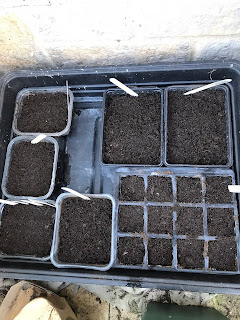Where wildlife is concerned, you need to be careful what you wish for. As I’ve noted before, if you seek to attract wildlife to the garden, you can’t be too particular about what wildlife will turn up; you might create an ideal habitat for a hedgehog and end up with a rat instead. Not quite what was intended; but that’s wildlife for you.
 |
| Woodworm work |
Down at the far end of the veg patch, against the edge of the Dump, I have a line of part-rotten logs, originally intended as firewood but too old to be of use. They partly fill the need for a dividing line between the two areas (the trellis that was originally there having long since fallen apart, you can see its remains at the top of the photo), and partly provide some ‘dead wood’ to attract insect life. I was hoping for stag beetles, but instead I’ve got woodworm. The other day I noticed that two of them had mostly disappeared in recent weeks, leaving not much more than the bark. There were some woodworm holes, so it wasn’t too hard to work out what had happened. Rotten wood is good for the hotbin; I broke some apart, to the requisite small size, and found a couple of fat white caterpillars, so I now know what woodworm larvae look like. I would still rather have the stag beetles, which are at least endangered. But the logs were put there to break down, so I can't complain.
More puzzling is the apple conundrum. We have a stash of cooking apples in the summerhouse, where
they’re keeping quite well in the cool but protected conditions; I have cooked
with a couple of them, but really they’re for feeding the blackbirds. I’ve been putting them out on the patio one
at a time, where they’re gratefully received by our blackbird pair. One day last week I noticed that, although the
apple had been fairly intact in the late afternoon, by the following morning it
was gone. Now, it’s not unusual for the
birds to toss an apple into a corner, especially if there wasn’t much of the
fruit left; pecking at the scant remains of an apple can cause it to wander off
the patio, or a bird might deliberately take it away to eat it quietly out of
sight. But it’s unusual for a nearly
whole apple to be moved away; these are big apples. Anyway, I put a fresh one out; with the same
result next day. After a couple more
days, I came to the conclusion that something was coming along in the night or
early morning and making off with them. I
don’t know what; it would have to be a fairly large animal, with a big enough
mouth to grasp the fruit. A squirrel or
rat wouldn’t be big enough, surely. My
money’s on a fox, and they do have a taste for fruit. I’d rather save my apples for the blackbirds,
so I’ve taken to covering the day’s apple with an empty flowerpot each evening
and uncovering it again in the morning.
I hope the blackbirds appreciate the effort!
The 'right' wildlife, meanwhile, is busy doing what wildlife does in early spring. The sparrows are holding moss-gathering
parties, the robin is giving little presents of food to his mate and the
pheasant is solicitously escorting his ladies as they pick up seeds under the
feeders. Lefty our elderly lame
woodpigeon continues to come for his breakfast in the mornings, and has enjoyed
a couple of leisurely soaks in the birdbath, lifting his wings one at a time to
let the sun - and the warmth - get underneath, the very picture of contentment.
 |
| Lefty takes a bath |






